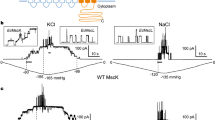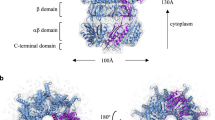Abstract
The crystal structure of an open form of the Escherichia coli MscS mechanosensitive channel was recently solved. However, the conformation of the closed state and the gating transition remain uncharacterized. The pore-lining transmembrane helix contains a conserved glycine- and alanine-rich motif that forms a helix-helix interface. We show that introducing 'knobs' on the smooth glycine face by replacing glycine with alanine, and substituting conserved alanines with larger residues, increases the pressure required for gating. Creation of a glycine-glycine interface lowers activation pressure. The importance of residues Gly104, Ala106 and Gly108, which flank the hydrophobic seal, is demonstrated. A new structural model is proposed for the closed-to-open transition that involves rotation and tilt of the pore-lining helices. Introduction of glycine at Ala106 validated this model by acting as a powerful suppressor of defects seen with mutations at Gly104 and Gly108.
This is a preview of subscription content, access via your institution
Access options
Subscribe to this journal
Receive 12 print issues and online access
$189.00 per year
only $15.75 per issue
Buy this article
- Purchase on Springer Link
- Instant access to full article PDF
Prices may be subject to local taxes which are calculated during checkout







Similar content being viewed by others
Accession codes
References
Sackin, H. Mechanosensitive channels. Annu. Rev. Physiol. 57, 333–353 (1995).
Hamill, O.P. & Martinac, B. Molecular basis of mechanotransduction in living cells. Physiol. Rev. 81, 685–740 (2001).
Booth, I.R. Bacterial ion channels. In Genetic Engineering: Principles and Methods Vol. 25 (ed. Setlow, J.K.) 91–112 (Kluwer Academic/Plenum Publishers, New York, 2003).
Sukharev, S.I., Blount, P., Martinac, B. & Kung, C. Mechanosensitive channels of Escherichia coli: the MscL gene, protein, and activities. Annu. Rev. Physiol. 59, 633–657 (1997).
Perozo, E. & Rees, D.C. Structure and mechanism in prokaryotic mechanosensitive channels. Curr. Opin. Struct. Biol. 13, 432–442 (2003).
Blount, P. Molecular mechanisms of mechanosensation: big lessons from small cells. Neuron 37, 731–734 (2003).
Booth, I.R., Edwards, M.D. & Miller, S. Bacterial ion channels. Biochemistry 42, 10045–10053 (2003).
Sukharev, S.I., Blount, P., Martinac, B., Blattner, F.R. & Kung, C.A. Large-conductance mechanosensitive channel in E. coli encoded by MscL alone. Nature 368, 265–268 (1994).
Levina, N. et al. Protection of Escherichia coli cells against extreme turgor by activation of MscS and MscL mechanosensitive channels: identification of genes required for MscS activity. EMBO J. 18, 1730–1737 (1999).
Li, Y., Moe, P.C., Chandrasekaran, S., Booth, I.R. & Blount, P. Ionic regulation of MscK, a mechanosensitive channel from Escherichia coli. EMBO J. 21, 5323–5330 (2002).
Chang, G., Spencer, R.H., Lee, A.T., Barclay, M.T. & Rees, D.C. Structure of the MscL homolog from Mycobacterium tuberculosis: a gated mechanosensitive ion channel. Science 282, 2220–2226 (1998).
Bass, R.B., Strop, P., Barclay, M. & Rees, D.C. Crystal structure of Escherichia coli MscS, a voltage-modulated and mechanosensitive channel. Science 298, 1582–1587 (2002).
Blount, P., Sukharev, S.I., Moe, P.C., Nagle, S.K. & Kung, C. Towards an understanding of the structural and functional properties of MscL, a mechanosensitive channel in bacteria. Biol. Cell. 87, 1–8 (1996).
Ou, X., Blount, P., Hoffman, R.J. & Kung, C. One face of a transmembrane helix is crucial in mechanosensitive channel gating. Proc. Natl. Acad. Sci. USA 95, 11471–11475 (1998).
Sukharev, S., Durell, S.R. & Guy, H.R. Structural models of the MscL gating mechanism. Biophys. J. 81, 917–936 (2001).
Perozo, E., Cortes, D.M., Sompornpisut, P., Kloda, A. & Martinac, B. Open channel structure of MscL and the gating mechanism of mechanosensitive channels. Nature 418, 942–948 (2002).
Anishkin, A. & Sukharev, S. Water dynamics and dewetting transitions in the small mechanosensitive channel MscS. Biophys. J. 86, 2883–2895 (2004).
Sotomayor, M. & Schulten, K. Molecular dynamics study of gating in the mechanosensitive channel of small conductance MscS. Biophys. J. 87, 3050–3065 (2004).
Miller, S. et al. Domain organization of the MscS mechanosensitive channel of Escherichia coli. EMBO J. 22, 36–46 (2003).
Schumann, U., Edwards, M.D., Li, C. & Booth, I.R. The conserved carboxy-terminus of the MscS mechanosensitive channel is not essential but increases stability and activity. FEBS Lett. 572, 233–237 (2004).
Miller, S., Edwards, M.D., Ozdemir, C. & Booth, I.R. The closed structure of the MscS mechanosensitive channel. Cross-linking of single cysteine mutants. J. Biol. Chem. 278, 32246–32250 (2003).
Koprowski, P. & Kubalski, A. C-termini of the Escherichia coli mechanosensitive ion channel (MscS) move apart upon the channel opening. J. Biol. Chem. 278, 11237–11245 (2003).
Pivetti, C.D. et al. Two families of mechanosensitive channel proteins. Microbiol. Mol. Biol. Rev. 67, 66–85 (2003).
Blount, P., Schroeder, M.J. & Kung, C. Mutations in a bacterial mechanosensitive channel change the cellular response to osmotic stress. J. Biol. Chem. 272, 32150–32157 (1997).
Okada, K., Moe, P.C. & Blount, P. Functional design of bacterial mechanosensitive channels. Comparisons and contrasts illuminated by random mutagenesis. J. Biol. Chem. 277, 27682–27688 (2002).
Martinac, B., Buehner, M., Delcour, A.H., Adler, J. & Kung, C. Pressure-sensitive ion channel in Escherichia coli. Proc. Natl. Acad. Sci. USA 84, 2297–2301 (1987).
Sukharev, S.I., Martinac, B., Arshavsky, V.Y. & Kung, C. Two types of mechanosensitive channels in the Escherichia coli cell envelope: solubilization and functional reconstitution. Biophys. J. 65, 177–183 (1993).
Miller, S., Ness, L.S., Wood, C.M., Fox, B.C. & Booth, I.R. Identification of an ancillary protein, YabF, required for activity of the KefC glutathione-gated potassium efflux system in Escherichia coli. J. Bacteriol. 182, 6536–6540 (2000).
Kim, S., Chamberlain, A.K. & Bowie, J.U. Membrane channel structure of Helicobacter pylori vacuolating toxin: Role of multiple G G motifs in cylindrical channels. Proc. Natl. Acad. Sci. USA 101, 5988–5991 (2004).
Edwards, M.D., Booth, I.R. & Miller, S. Gating the mechanosensitive channels: MscS a new paradigm? Curr. Opin. Microbiol. 7, 163–167 (2004).
McLaggan, D. et al. Analysis of the kefA2 mutation suggests that KefA is a cation-specific channel involved in osmotic adaptation in Escherichia coli. Mol. Microbiol. 43, 521–536 (2002).
Liang, J. Experimental and computational studies of determinants of membrane-protein folding. Curr. Opin. Chem. Biol. 6, 878–884 (2002).
Eilers, M., Patel, A.B., Liu, W. & Smith, S.O. Comparison of helix interactions in membrane and soluble alpha-bundle proteins. Biophys. J. 82, 2720–2736 (2002).
Dawson, J.P., Weinger, J.S. & Engelman, D.M. Motifs of serine and threonine can drive association of transmembrane helices. J. Mol. Biol. 316, 799–805 (2002).
Chervitz, S.A. & Falke, J.J. Molecular mechanism of transmembrane signaling by the aspartate receptor: a model. Proc. Natl. Acad. Sci. USA 93, 2545–2550 (1996).
Bartlett, J.L., Levin, G. & Blount, P. An in vivo assay identifies changes in residue accessibility on mechanosensitive channel gating. Proc. Natl. Acad. Sci. USA 101, 10161–10165 (2004).
Sukharev, S. Purification of the small mechanosensitive channel of Escherichia coli (MscS): the subunit structure, conduction, and gating characteristics in liposomes. Biophys. J. 83, 290–298 (2002).
Blount, P., Sukharev, S.I., Schroeder, M.J., Nagle, S.K. & Kung, C. Single residue substitutions that change the gating properties of a mechanosensitive channel in Escherichia coli. Proc. Natl. Acad. Sci. USA 93, 11652–11657 (1996).
Lowry, O., Rosebrough, N., Farr, A. & Randall, R. Protein measurement with the folin phenol reagent. J. Biol. Chem. 193, 265–275 (1951).
Hamill, O.P., Marty, A., Neher, E., Sakmann, B. & Sigworth, F.J. Improved patch-clamp techniques for high-resolution current recording from cells and cell-free membrane patches. Pflug. Arch. Eur. J. Phy. 391, 85–100 (1981).
Blount, P., Sukharev, S.I., Moe, P.C., Martinac, B. & Kung, C. Mechanosensitive channels of bacteria. Methods Enzymol. 294, 458–482 (1999).
Bower, M.J., Cohen, F.E. & Dunbrack, R.L. Prediction of protein side-chain rotamers from a backbone-dependent rotamer library: A new homology modeling tool. J. Mol. Biol. 267, 1268–1282 (1997).
Kim, S., Chamberlain, A.K. & Bowie, J.U. A simple method for modeling transmembrane helix oligomers. J. Mol. Biol. 329, 831–840 (2003).
Kelley, L.A., Gardner, S.P. & Sutcliffe, M.J. An automated approach for clustering an ensemble of NMR-derived protein structures into conformationally related subfamilies. Protein Engineering 9, 1063–1065 (1996).
Brunger, A.T. et al. Crystallography & NMR system: a new software suite for macromolecular structure determination. Acta Crystallogr. D 54, 905–921 (1998).
Martz, E. Protein explorer: easy yet powerful macromolecular visualization. Trends Biochem. Sci. 27, 107–109 (2002).
Acknowledgements
This research was supported by The Wellcome Trust (040174) (I.R.B., S.M. and M.D.E.), by the European Union Fifth Framework Programme (W.B.) (Hypersolutes; contract no. QLK3-CT-2000-00640), by the UK Biotechnology and Biological Sciences Research Council and Unilever (S.D. and S.B.), grants GM61028 and DK60818 from the US National Institutes of Health (NIH) (P.B.), grant I-1420 of the Welch Foundation (Y.L. and P.B.) and grant F49620-01-1-0503 of the Air Force Office of Scientific Review (I.I. and P.B.), and NIH grant R01 GM063919 (J.U.B.). The authors also thank L. Moir, P. Moe and U. Schumann for their contributions to this work. We thank S. Sukharev and D. Rees for preprints.
Author information
Authors and Affiliations
Corresponding author
Ethics declarations
Competing interests
The authors declare no competing financial interests.
Rights and permissions
About this article
Cite this article
Edwards, M., Li, Y., Kim, S. et al. Pivotal role of the glycine-rich TM3 helix in gating the MscS mechanosensitive channel. Nat Struct Mol Biol 12, 113–119 (2005). https://doi.org/10.1038/nsmb895
Received:
Accepted:
Published:
Issue Date:
DOI: https://doi.org/10.1038/nsmb895
This article is cited by
-
Mechanosensitive aquaporins
Biophysical Reviews (2023)
-
Structural mechanism for gating of a eukaryotic mechanosensitive channel of small conductance
Nature Communications (2020)
-
Life behind the wall: sensing mechanical cues in plants
BMC Biology (2017)
-
The role of lipids in mechanosensation
Nature Structural & Molecular Biology (2015)
-
The evolutionary ‘tinkering’ of MscS-like channels: generation of structural and functional diversity
Pflügers Archiv - European Journal of Physiology (2015)



